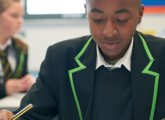As a full-time teacher of English, media and drama, the topic of heroes and the heroic was one that came up frequently. It still does now I am freelance, travelling the UK delivering active workshops on the likes of Beowulf and his unapologetic boasting as prelude to confrontations with monsters, or Macbeth, whose final defiance in the face of Malcolm’s army arguably marks a recovery of the energy and courage that his crimes and scheming had obscured and perverted. It has become even more central a theme when considering the life and times of Horatio Lord Nelson.
For the past two years I have been collaborating with historian Peter Warwick – author of The Voices From The Battle of Trafalgar – in the creation of a one-day workshop designed to teach Key Stage 2 and 3 students something of the importance of Nelson in our island’s story and also the broader context within which his achievements sit. The project is an on-going one thanks to the support of the 1805 Club, which has funded the initial series of ‘pilot’ workshops as a prelude to our seeking the additional funding needed to broaden the programme.
It is at this crossroads that the project now sits. And while the workshops remain a work in progress, a core of highly active and interactive elements has emerged, some of which will be explained here: ideal introductions to Nelson, his significance, and the extraordinary life aboard the ships he commanded..
STARTER ACTIVITY
On the 24th July (the day I am writing this) 1797 Nelson wrote to the commander in chief of the Mediterranean fleet Admiral, Sir John Jervis (later Earl St Vincent) prior to the sea-borne attack on the port of Santa Cruz de Tenerife during which he sustained the injuries that resulted in the amputation of his right arm. In his letter he said ‘Tomorrow my head will probably be covered with laurel or Cyprus.’ This was a permutation of a favourite formula used by Nelson time and again prior to battles, and is highly suggestive of the kind of ‘risk-all’ role he took on such occasions. To get students into the shoes of the man, invite them to move around the room sharing this bold but quite self-conscious statement; speaking it in turns to one another, and then reflecting on it both in terms of the courage and self-promotion it hints at.
MAIN ACTIVITIES
1 NELSON – DEATH AND THE SAINT
Project or distribute Arthur Devis’ famous picture The Death of Nelson painted in 1807. It is not important to know precisely who everyone is – though the Wikipedia site does identify them. The important discussions here relate to the possible liberties with truth that Devis may have taken in creating this famous image. Remember that the orlop deck where Nelson was carried to was far more ‘low-ceilinged’ than the space depicted here, and it fantastical to think such a crowd would have gathered around Nelson at the height of the Battle. The task for students is to try to spot the underlying geometry that governs the arrangement of the figures – perhaps drawing the shapes they can see for themselves. The key thing is that students recognise how constructed the picture is. It would be valuable to compare it also to any medieval or Renaissance ‘Christ’s Deposition From The Cross’ to help students see how painters borrow from an image tradition. That such pictures might be a source for Devis is also suggestive of the kind of ‘sainthood’ that would be bestowed on Nelson.
Now project or distribute the extraordinary Immortality of Nelson by Charles Theodosius Heath. It reflects the next advance in Nelson hero-worship following his death. The detailed description of the picture and its myriad symbols and emblematic figures is provided at the Royal Greenwich Museum’s online pages dedicated to the picture (see You Will Need).
Ideally teachers should explain the picture and get students to practise some of its specialist vocabulary: ‘Britannia’; ‘Neptune’; ‘hippocampi’; or ‘putti’. In order to help students get close to the picture, put them in pairs and then designate one ‘the sculptor’ and the other ‘the clay’. In each case the pair must select a figure in the picture to create, keeping their choice secret from others. The challenge then is for a chosen sculptor to build their figure, slowly manipulating their classmate into the right shape. The rest can call ‘freeze’ at any stage, with the ‘sculptor’ taking suggestions from the ‘audience’ as to what bit of the picture (s)he is creating. The audience should be encouraged to use the correct vocabulary to describe the figures.
2. THE LEADER
Heroism; vocation; compassion; courage; passion; loyalty; diligence; self-sacrifice; consideration for his men; inspiration; rigour, and a thirst for glory
All of these qualities have been attributed to Nelson by his biographers over the last 213 years since Trafalgar. There were other, less positive characteristics too. He was a flawed man, doubtless, but he was loved by those he commanded and proved a source of inspiration when it really mattered. A simple way of helping students gain a better understanding of Nelson and the ‘Nelson Touch’ that marked out his leadership, is to invite students to create a living virtue line of frozen scenes depicting these characteristics.
If time allows, watch Peter Weir’s wonderful 2003 film Master and Commander and keep a tally of the ‘Nelsonian’ leadership traits apparent in Russell Crowe’s depiction of Captain Jack Aubery. Another terrific exercise would be to read an account such as that in Christopher Hibbert’s biography of Nelson (pages 121-126) of Nelson’s behaviour following his injury at Santa Cruz de Tenerife.
A further, useful source of online information about Nelson’s genius for leadership can be found at: aboutnelson.co.uk/nelsons genius.htm








